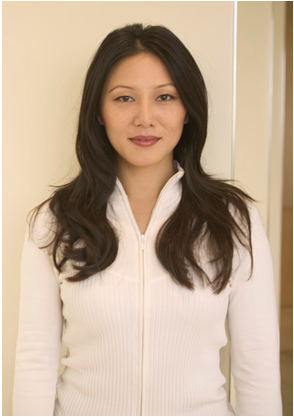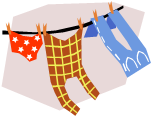Posture
Disclaimer: I am NOT an Alexander Technique Teacher nor a Feldenkrais practitioner and the following advise is based on personal experience and/or information from renowned teachers / practitioners. I encourage any performer and especially singers to take Alexander Technique Lessons or practice the Feldenkrais with a qualified teacher / practitioner.
Proper posture is important for most musicians and performing artists, but it is crucial for the singer for a number of reasons:
- Our body is our instrument: a singer attempting to sing with a bad posture is like a flutist trying to play a bended or broken flute, wondering why it is so much harder, or altogether impossible to produce the same pure sound that it produced when it was straight...
- Other musicians can “hide” behind their instrument and even if they do not, they usually look at their instrument or at least direct most of their attention to it. Singers do not have that privilege; we have to sing out directly to the audience. Add to that the other difference between singers and other musicians - text. Singers sing words and deliver a message - that makes us actors. As actors, not only our tone matters but all our bodily and facial gestures. The public demands that and art demands that as well.
- Good posture makes us feel and look good and confident, others react to that and then we feel even better. Poor posture is depressing (to oneself and whomever is watching) and does not invite success.
I included not only a discussion of the posture of the whole body (let’s call it macro-posture), but more detailed information about the proper position of the head-neck and facial muscles (mini-posture) and even internal muscles such as tongue (micro-posture).
Practice finding a balanced posture in front of a mirror. Find a posture that looks noble and appealing; something that looks like your better you. When you found it - you probably found your right posture.
Body Posture Guidelines
I strongly recommend any performer to take Alexander Technique lessons. The technique is based on four basic principles:- Let the neck be free - so the head can move forward and up, away from the top of the spine.
- Allow the torso to lengthen upward, and widen - fanning to its full width.
- Allow the legs to release away from the hip joint.
- Allow the shoulders to release out to the side, and float on the ribcage.
This technique uses both verbal instruction and sensations. It gives general guidelines; but with a good teacher - those general instructions will feel very specific.

I find that the Feldenkrais Method complements the Alexander Technique; Feldenkrais focuses more on functionality and motion (finding the most efficient movement for each individual) while Alexander is more about a state. The posture or desired state in Alexander is a flexible state that has a possibility and ease of movement in it (notice the choice of words in the basic guidelines: lengthen, move forward and up, release away, release out, float - they all have to do with movement) but this movement is done in the head - you think it. While in the Feldenkrais Method the movement is teaching the subconscious mind how to function and move more efficiently. Both methods are educational methods. I studied both and can give you some insight, but I encourage you to take lessons with a professional teacher. Later we can try to implement those guidelines while singing.
Some more specific guidelines follow:
- Legs: stand with legs apart (not as wide as your shoulders - that would be too vulgar), one leg a bit forward. Do not lock your knees, but do not bend them either. Lean slightly forward; feel that you have just a little bit more weight on your toes than on your heals. Find a position that you feel are very stable, and would not move if someone pushed you.
- Torso: present an open chest - massage your upper chest as if you are ironing it - making it wider. We need to have as much space for the lungs as possible. If you are shy - think proud. Your posture should be straight but not too tight in a military fashion - it should be noble.
- Back: think of a wide and long back. your back should be as open as your chest - do not over extend the chest to a point that your back looses its width. Breath in deeply and feel your shoulder blades move apart. Put your hands on your lower back and breath into your hands - feel the lower back extending and pushing your hands. Imagine that your back opens with each breath like the wings of a beetle.
- Arms & shoulders: find a balanced position for the shoulders that will not be tight and will not close the chest. Most people bend slightly forward which means that most of us should think of pulling the shoulders slightly backwards. The arms have a weight of a couple of pounds - let them fall to the sides of your body and let their weight help in opening the chest. Many students, when trying to concentrate create tension in their hands and fingers while singing. Be aware and do your best to avoid it and release any tension in the arms, hands and fingers - before it turns into a habit.
- Abdomen: do not tuck your tummy in, “feel fat” and let it out. Do not push it out, but allow it to feel free.
- Centre: feel very stable in your “centre” - your abdomen-lower back-pelvis-upper thigh area; feel alert, powerful and flexible.
▲top
Head, Neck and Face Guidelines
As Alexander said: “Let the neck be free - so the head can move forward and up, away from the top of the spine”. The face should look natural. Sometimes we will use funny faces for a specific exercise, but in proper singing - eventually we have a natural face (no funny singing faces).
In detail:
- Inner smile
- Relax your jaw (see tips)
- Release the neck: the larynx should be free to move, respond to the airflow and be as flexible as possible. We need to release all muscles tension in the neck to allow freedom of the larynx. One exercise would be to move your head slowly from side to side while singing.
- Many people find that dropping the head just slightly releases the neck too.
- Look straight ahead, just below the horizon. Imagine a big hall, look far away into a large audience.
- High/low notes: do not lower or raise your head for high/low notes. If you feel you must do a movement - do the opposite of what comes natural to you, until you learn to stay in a comfortable relaxed position for all notes.
- Feel that your head is hung by a string from above and does not have any weight. Make sure that sensation does not interfere with the feeling of being stable and connected to the ground.
- Relax your facial muscles. Many times when we experience difficulty we do not use our body efficiently and we compensate by using different muscles, often it would be facial muscles. Be aware and watch yourself in the mirror: do you look up to reach a high note, do you raise your eyebrows, bend slightly forward? Try to do the opposite movement and teach your body and your voice to find a more efficient solution, not a superficial, forced one.
- Imagine that you have a huge wide nose.
- Be aware of the size of your vocal tract. Touch the top of your hard palate - it is higher than we think. Make use of all that space.

▲top
Vocal Tract Guidelines
The shape and texture of the vocal tract defines the color of our voice. Below are basic guidelines that will make your vocal tract resonate more efficiently and beautifully. Advanced students learn to allow even more flexibility in the vocal tract and create a different color and tone for each vowel, pitch, musical style, emotion etc.
- Allow the tongue to be flat and low; this creates more space in the mouth and by that allows your voice to resonate. Do not push it down; find a relaxed way of it being flat in your mouth, the tip touching the top of the front lower teeth (or just behind them, depending on the vowel) but not pressing against the teeth. The back of the tongue should be wide and low, far from the velum.
- Raise your soft palate and uvula away from the tongue. Make the glossopalatine and pharyngopalatine arches bigger and wider. Use a mirror and a flashlight if necessary. Raising the soft palate in chest and lower middle voice might sound a bit too “operatic” and unfitting to non-classical music. It is necessary though for higher notes in any musical style.
- Make a big space in your mouth. More space for higher notes (imagine an inch between your molars!). The lips can be almost closed, not revealing the “secret” of the inside of your mouth. Be aware that the hard palate is very high and use that space when singing and when breathing (feel the air blowing on it).
- We want to feel nasal vibrations but without a nasal sound (unless it is a nasal consonant or vowel). Experiment until you find a clear non nasal sound. To check if your tone is nasal, close your nose while you sing. If the sound changes - this means that air was escaping through the nose and your sound is at least partially nasal.
- The lips should be slightly forward (in all vowels) for the same acoustic reason as a trumpet bell.
 Learn from babies! They have such a small body, lungs, vocal folds and still they can be loud! If you click on the crying baby you will see a heartbreaking collage of crying babies. Now put your emotions aside and learn from them - they all use their voice efficiently. Notice how the tongue is flat and low, how they create a huge space in their small mouths. You can also learn about support. Their crying is not always so beautiful, but it is loud and efficient - learn the efficient part and their lack of inhibitions. Next time you see a crying baby - find something positive in this frustrating moment - learn from her! You might learn so much that you will be sorry when she stopped crying...
Learn from babies! They have such a small body, lungs, vocal folds and still they can be loud! If you click on the crying baby you will see a heartbreaking collage of crying babies. Now put your emotions aside and learn from them - they all use their voice efficiently. Notice how the tongue is flat and low, how they create a huge space in their small mouths. You can also learn about support. Their crying is not always so beautiful, but it is loud and efficient - learn the efficient part and their lack of inhibitions. Next time you see a crying baby - find something positive in this frustrating moment - learn from her! You might learn so much that you will be sorry when she stopped crying...
▲top
Tips for Solving Common Problems
- Before you sing - warm up your body. Below are some suggestions, but do make up your own exercises:
- Stretch your whole body, lift your arms and your hands to the sky, stretch some more... and release
- Throw your torso down and lift is slowly placing one vertebra on top of another. You can end up standing straight or lift your arms up and then let them go down to the sides of your body
- Jump and release your body, arms, legs, neck.
- Tap on your arms and legs to increase blood flow (do not hurt yourself, it should feel good)
- Roll your shoulders forward and then backwards (both together or one after the other)
- Massage your neck
- Move your neck from side to side and in circles (not backwards and up - only sideways and forward) with a slow flowing movement
- Extend your arms sideways, open your hands and extend your fingers, open a HUGE mouth, open your eyes wide then close everything to a very tight state: face, fist, shrink your torso. Repeat
- Massage your face (chin, forehead, sides, mouth, lips and the “mask” area - cheekbones and nose), while making funny humming / yowling sounds going up and down
- Make variations on those exercises or make up your own exercises that make you feel good
- How to relax and release jaw tension:
- Think stupid
- Chew
- Move it from side to side
- Hold your face as if caressing your beard (or imaginary beard)
-
 Imagine that you are unhinging the mandibular joint and let it drop like hung laundry. Feel the hole opening in the hinge close to your ears, below your temples.
Imagine that you are unhinging the mandibular joint and let it drop like hung laundry. Feel the hole opening in the hinge close to your ears, below your temples. - Put a finger between your upper lip and nose - direct the air to that point. Strangely it releases jaw tension.
- Put a finger on your chin and move it while you sing
- Massage the muscle that hold your jaw - you can reach it inside your mouth - it is just behind your upper molars.
- Roll a paper or business card to form a cigarette shaped paper. Hold it in your lips without pressing your lips. This will keep your jaw alert yet very relaxed. Do not use this exercise if it will tempt you to really smoke a cigarette! The damage of cigarettes is much worse than the advantage of this exercise.
- How to relax and release tongue tension:
- Many of the tips for releasing the jaw work on the tongue as well
- Put your thumb under your chin behind the chin bone. You will feel the mylohyoid muscle which forms the floor of the oral cavity. Move it and make sure it is soft. Tighten your tongue to feel how the muscle becomes harder and then release it. Then do it while singing. Then try to stay with a soft tongue and muscle while singing.
- Vocal exercises with fast tongue movement such as tongue trill, rapid vowel changes, for example [luI-luI-luI]. Let your tongue be active like a snake’s, make sure your vowels are true while having minimal jaw movement.
- That tongue is so annoying - don’t you feel like cutting it off sometimes? ☺ (this is a joke - DO NOT cut your tongue, and do not sue me...)
- Raising velum exercises:
- Yawn (inhalation = yawn, phonation = sigh) making sure your tongue is not pulled backwards and is flat
- Pretend to throw up - that will open your vocal tract (avoid thinking about the negative sides of vomiting)
- Inner smile. Feel the space behind your upper molars; imagine that your mouth is widening and your right and left upper molars are moving further away from each other.
- Put a pencil between your teeth (click here or here to view how)
- Imagine there is a deadly virus at the tip of your pencil. Point the tip of the pencil into your wide open mouth - do not touch yourself with that deadly virus! Then you find out how much more space you can make inside your mouth...
- Talk like a pompous aristocratic brit.
- Imagine a hot potato in your mouth.
- Imagine a good smell - smell it all the way to the back of your vocal tract.
▲top
Posture Links
Most of the links have to do with The Alexander Technique, which I strongly recommend for performers and everybody. I hope reading about it will convince you to give it a try - choose a teacher from the links below.
- CanSTAT - The Canadian Society of Teachers of the F. M. Alexander Technique: Finding a Teacher of the Alexander Technique (Ontario)
- Alexander Technique Photos
- The Complete Guide to the Alexander Technique: includes a lot of info for singers and singing teachers.
- The Alexander Technique for Musicians: Born to Sing by Ron Murdock (highly recommended)
- Correct Posture For Singers by The School for F.M. Alexander Studies (Australia)
- The Alexander Technique for Musicians: Playing In The Key Of Ease!
- Alexander Technique Education: Postural Mechanisms
- How to Improve Your Posture
- The Posture Page: provides practical information about methods that have a history of helping people improve their posture.
- Energize with Proper Posture: These 3 posture stretches that will make you feel great! (simple and fun)
- Posture Exercises: Learn about Posture and How to Improve it using Posture Exercises. I recommend reading and viewing most articles in this blog. There is a bit of babbling in the videos, but they contains professional and detailed information.
- Pilates exercises: How To Find Neutral Spine Position
- Correct Posture for Singers, Public Speakers, Actors and All People. I do not agree with everything, but it is an easy read and he has some good points.
▲top
Posture Quiz

Analyze the posture of the lady in blue; the good and the bad and how would you make her stand better for singing. Click on image for larger view. Email your analysis.

